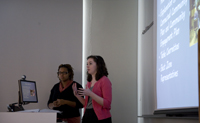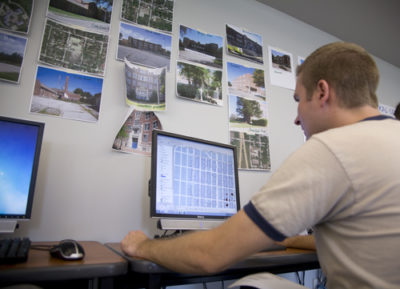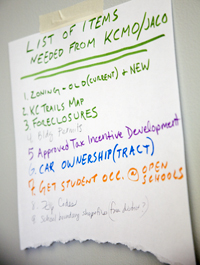Urban Planning + Design students present plan for repurposing empty KCMO schools
In an effort to repurpose the Kansas City, Missouri School District’s (KCMSD) 41 empty buildings, the College of Arts and Sciences’ Department of Architecture, Urban Planning and Design (AUP+D) fourth-year Urban Planning + Design Studio presented a strategic plan to an audience of civic and community leaders on Thursday, Dec. 16, 2010. Among those in attendance were Airick Leonard West, KCMSD Board president and Shannon Jaax, KCMSD building repurposer and one of the studio’s advisors.
“I thought the students did a wonderful job – they presented an amazing volume of work, a lot of fact-based analysis that will be very useful to the Kansas City, Missouri School District,” said Daniel Musser, one of the studio’s advisors and Senior Vice President – Principal of Zimmer Real Estate Services. “This [research] represents a quarter million dollars worth of consulting work for the Kansas City, Missouri School District.”
In March of 2010, in response to a $50 million budget shortfall, the KCMSD voted to close 29 of its 61 schools. Almost a year later, those buildings – and about 15 other former school buildings – sit vacant, some in serious disrepair.
“We chose this project because it’s very complex, topical and important to the community,” said Vicki Noteis, AIA and fourth-year studio instructor. “We hope the community will see the big picture instead of focusing on just one building. People need to have the sense that they’re all in this together, instead of feeling like they’re isolated. They need ideas and information.”
From their spacious, new sunlit studio in Katz Hall, Urban Planning + Design students have covered every surface with statistics, maps and sketches. For about 20 to 30 hours each week, students have focused on the following projects:
- Review of History, Context and Existing Conditions:Students became familiar with the broad historic and contextual issues that formed the KCMSD and led to its current condition. Using information from speakers, site visits and reading material, students presented a KCMSD facility overview to faculty and the Studio Advisory Group, made up of the following professionals:
- A city council member
- A city planner
- A KCMSD advisory board member
- A real estate developer and executive
- The American Institute of Architects president
- The Urban League of Greater Kansas City president
- Data Review and Analysis: For a month, students collected, reviewed and analyzed KCMSD data. They developed a summary of building conditions, a list of facilities on the National Register of Historic Places, a demographics map and an understanding of existing city plans.
- Development of Strategic Alternatives for District Decision-Making: Next, students conducted a planning charette – a final, intensive effort to finish an architectural design project – and presented pertinent data to the Studio Advisory Group.
- Design a Community Engagement Process: Then, students investigated best practices for engaging the community, attended planning project meetings and met with local experts, neighborhood leaders and activists.
- Refine KCMSD Guidebook for Repurposing Strategy: With input from the Studio Advisory Group, students selected the most promising strategic concept from the planning charette. For six weeks, students created a guidebook to assist the KCMSD in decision-making and implementation of a five-year building repurposing strategy.

Fourth-year Urban Planning + Design students present a KCMSD facility overview to faculty and a Studio Advisory Group.
While half of their classmates developed geographic information system (GIS) reports from a wall of computers, Andy Clarke and Jesse Lange, senior urban planning and design students, interpreted district maps from their design tables. Clarke and Lange developed a plan that would encourage community support in repurposing the empty buildings.
“We’re dealing with the challenge of organizing decades of disorganization,” Clarke said. “A student who lives in Hyde Park, for example, would need to walk five miles and past a highway to arrive at a school. We’re also developing a plan for community anchors, such as a community center, so the site can serve the community.”
As one of the studio’s advisors, Troy Nash – vice president and director of Public Sector Consulting at Zimmer Real Estate Services, LC and past KCMO city council member – strived to provide students with a “real world” experience and advice.
“This studio allows students to take what they learn in class beyond the theoretical framework,” Nash said. “AUP+D is really helping Kansas City by providing solutions that are grounded in sound urban development principles. Coupled with the urban focus of the Henry W. Bloch School of Business and Public Administration, School of Law and the College of Arts and Sciences’ Department of Economics, AUP+D enhances UMKC’s standing as a useful community partner.”
Media Coverage:
UMKC finals project helps KCMO schools – NBC Action News
UMKC students to present plans for empty schools – The Wednesday Sun
UMKC students help plan new uses for closed KC schools – The Kansas City Star


